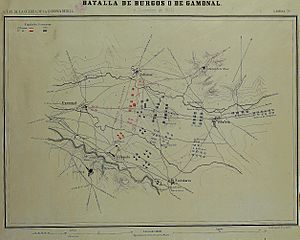Battle of Gamonal facts for kids
Quick facts for kids Battle of Gamonal |
|||||||
|---|---|---|---|---|---|---|---|
| Part of the Peninsular War | |||||||
 "Battle of Burgos or Gamonal" (Atlas de la Guerra de la Independencia (National Library of Spain) |
|||||||
|
|||||||
| Belligerents | |||||||
| Commanders and leaders | |||||||
| Soult | Conde de Belvedere | ||||||
| Strength | |||||||
| 18,000 infantry 6,500 cavalry |
9,800 infantry 1,200 cavalry |
||||||
| Casualties and losses | |||||||
| 200 | 3,400 | ||||||
The Battle of Gamonal (also called the Battle of Burgos) was a major fight during the Peninsular War. It happened on November 10, 1808. The battle took place in the village of Gamonal, which is close to Burgos, Spain.
A powerful French army, led by General Soult, easily defeated the Spanish troops. The Spanish army was led by General Belvedere. This victory opened the way for the French to invade central Spain, including the capital city, Madrid.
Contents
Why the Battle Happened
Before the battle, the French leader Napoleon was in Vitoria, waiting for news. He wanted to hear that his army had taken control of Burgos. The French forces were very strong, with about 70,000 soldiers. Many of these were experienced cavalry (soldiers on horseback) from Germany.
Facing the French at Burgos was a small Spanish group of 1,600 soldiers. But on November 7, General Belvedere arrived from Madrid with more troops. He brought 4,000 foot soldiers and 400 cavalry. The next day, even more Spanish soldiers joined them.
By November 10, when the French attacked, General Belvedere had about 8,600 foot soldiers and 1,100 cavalry. He also had sixteen cannons.
The Battle Begins
The French army attacked the Spanish positions near Burgos. The French had twice as many soldiers as the Spanish. The Spanish troops were lined up on an open plain at Gamonal. This was not a good place to defend.
The French cavalry charged with great force. The Spanish soldiers panicked and ran away. This allowed the French invaders to take over Burgos and loot the city.
Historians say that if General Belvedere had stayed in Burgos, he could have used the city's old walls for defense. The ground around Burgos was also rough, which would have made it harder for the French to attack.
But Belvedere chose to march his army out of Burgos. He set them up on an open plain in front of Gamonal village. His right side was poorly protected by a river, and his left side was completely open.
In front of the Spanish line was a large wood. This wood helped the French hide their movements until the last moment. Belvedere placed his cannons in the middle of his line. He had six groups of soldiers in the front and a cavalry group on each side. More soldiers and cannons were coming up from the back. However, the battle was quick, and they did not get into position in time.
The French general Soult arrived with his light cavalry. Behind them were more cavalry and three groups of foot soldiers.
French Attack and Spanish Retreat
The French cavalry rode south, facing the Spanish right side. Four groups of French light cavalry were in the center. French foot soldiers moved through the wood on the left.
The French cavalry launched a powerful charge against the Spanish foot soldiers on the plain. The Spanish cavalry trying to protect their side were quickly pushed away. The Spanish foot soldiers were still in lines and did not have time to form defensive squares. About 5,000 French cavalry rode over them. They captured their flags and killed or captured half of the Spanish soldiers.
The remaining Spanish soldiers ran towards Burgos. The French cavalry chased them. At the same time, French foot soldiers attacked the Spanish from the front. The Spanish army was completely defeated. All sixteen Spanish cannons were captured. Some of these cannons had not even been set up to fire.
General Belvedere tried twice to gather his troops, but he could not stop them from running away. Only a few Spanish groups managed to hold their ground and retreat in an orderly way. These included the 4th Battalion of the Walloon Guards and the 1st Regiment of Provincial Grenadiers.
What Happened Next
After entering Burgos, the French army celebrated their victory by looting the city. Even houses near where Napoleon was staying were robbed and set on fire.
Napoleon's invasion of Spain continued with another battle, the Battle of Espinosa de los Monteros.
The Spanish losses at Gamonal and Espinosa de los Monteros caused about 20,000 regular soldiers to scatter. Many of these soldiers then formed guerrilla groups. These groups fought against the French using surprise attacks and small-scale warfare.
One of these guerrilla leaders was Juan Díaz Porlier. His group of regular troops became very active in northern Spain. By early 1811, his division was part of a larger army of guerrillas. This army had five divisions and totaled over 33,000 fighters.
See also
 In Spanish: Batalla de Gamonal (1808) para niños
In Spanish: Batalla de Gamonal (1808) para niños

